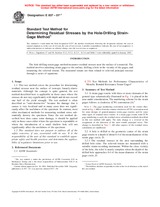Potřebujeme váš souhlas k využití jednotlivých dat, aby se vám mimo jiné mohly ukazovat informace týkající se vašich zájmů. Souhlas udělíte kliknutím na tlačítko „OK“.
ASTM E837-01e1
Standard Test Method for Determining Residual Stresses by the Hole-Drilling Strain-Gage Method (Includes all amendments And changes 12/31/2010).
Automaticky přeložený název:
Standardní zkušební metoda pro stanovení zbytkových napětí podle Hole- vrtání Tenzometrické Metoda
NORMA vydána dne 10.10.2001
Informace o normě:
Označení normy: ASTM E837-01e1
Poznámka: NEPLATNÁ
Datum vydání normy: 10.10.2001
Kód zboží: NS-48191
Počet stran: 10
Přibližná hmotnost: 30 g (0.07 liber)
Země: Americká technická norma
Kategorie: Technické normy ASTM
Anotace textu normy ASTM E837-01e1 :
Keywords:
hole-drilling, residual stress measurement, strain gages, stress analysis, ICS Number Code 77.040.10 (Mechanical testing of metals)
Doplňující informace
| Significance and Use | ||
|
Residual stresses are present in almost all structures. They may be present as a result of manufacturing processes or they may occur during the life of the structure. In many cases residual stresses are a major factor in the failure of a structure, particularly one subjected to alternating service loads or corrosive environments. Residual stress may also be beneficial as, for example, compressive stresses produced by shot peening. The hole-drilling strain-gage technique is a practical method for determining residual stresses. See Table 1. |
||
| 1. Scope | ||
|
1.1 This test method covers the procedure for determining residual stresses near the surface of isotropic linearly-elastic materials. Although the concept is quite general, the test method described here is applicable in those cases where the stresses do not vary significantly with depth and do not exceed one half of the yield strength. The test method is often described as "semi-destructive" because the damage that it causes is very localized and in many cases does not significantly affect the usefulness of the specimen. In contrast, most other mechanical methods for measuring residual stress substantially destroy the specimen. Since the test method described here does cause some damage, it should be applied only in those cases either where the specimen is expendable or where the introduction of a small shallow hole will not significantly affect the usefulness of the specimen. 1.2 This standard does not purport to address all of the safety concerns, if any, associated with its use. It is the responsibility of the user of this standard to establish appropriate safety and health practices and determine the applicability of regulatory limitations prior to use. |
||
| 2. Referenced Documents | ||
|




 Cookies
Cookies
